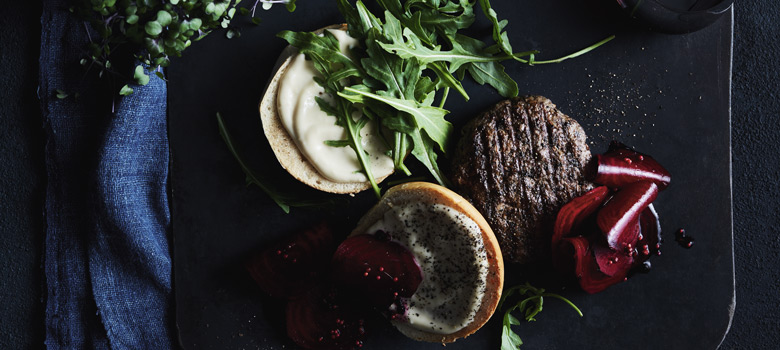
Food
Seasonal Beetroot
The beetroot made its way into Australian folklore smuggled in between a meat patty and a leaf of lettuce. Readers of a certain age will remember a hamburger purchased at the Milk Bar, the juices dribbling down your arms and gathering in little pools just below your elbows. It was meaty, and the smoky bacon was crisp. If you were particularly lucky, it was accompanied by a milkshake slurped from its silver canister through a paper straw (paper straws, now there’s an idea…).
The milk bar was quick to become the cornerstone of every country town and every city suburb. And yet, given the Greek heritage of many of the owners, the culinary and indeed aesthetic leaning of these milk bars is a curiosity. There was often a pinball machine, a juke box (playing American music) and, of course, the food they served.
The question as to why Australia’s Greeks found themselves an unwitting Trojan Horse for American culture is an interesting one. The early immigration wave came to our shores after America had shut her door to Greece. However, the ties to other family members and travellers meant that the American way of life and culinary culture was shared among the Greek community across
the ocean.
Needless to say, nothing exists in a bubble and it wasn’t long before our own flavour was imparted on the milk bar and, indeed, the hamburger. It is thought the opening of the Edgell cannery in 1926 and Golden Circle in 1947 played a role in that development. Enter a slice of tinned beetroot. (And, of course, enter the ring of pineapple.)
Both earthy and sweet, beetroots can now be found in a rainbow of colours and a variety of sizes at the farmers’ markets. The variety goes beyond the aesthetic, with the taste (and nutritional properties) varying too. Naturally, they now find celebration way beyond the tin: boiled, roasted, smoked, pickled, and steamed. Picked young, they are also wonderful just as they are – sliced finely and eaten raw with a splash of olive oil and a soupçon of vinegar.
Among the sweetest vegetables – with more sugar than sweet corn and carrots – some 20 to 30 per cent of the world’s sugar production comes from the sugar beet. This inherent sweetness allows the beetroot a place on the dessert trolley. Other members of the family include the mangal-wurzel (used for animal fodder), Swiss chard and the garden beet (where the roots and leaves are eaten as a vegetable).
While it is believed the Ancient Greeks cultivated beetroot as early as 300BC, they were grown for their leaves, not the taproot. Their unique colour has been used as a food colouring and they have also found a place in medicine for their high levels of folate. It was in the 1800s they were produced for sugar.
Australians were not alone in taking the beetroot and finding a unique place for it at the table. In Eastern Europe, you will find it in soups such as borscht; in India it is spiced and served as a side dish; while mixed with horseradish, it is made into chrain, a popular condiment in Russia and Hungary, or the Polish buraczki.
And then back to our humble hamburger, where the beetroot found its way via many Greek hands, much American influence and a booming canning industry, into our culinary culture. Food has a funny way of telling a story.
Select and store
Ideally fresh beetroots should have their greens intact – not only a great indicator of flavour, but a two for the price of one bonus, as you get the green leaves to cook too (just as you would spinach). The greens should be sprightly with no signs of spoilage. The beetroot should be firm, smooth, and vibrant in colour.
Keeping the skin intact will help to protect your fingers from beetroot stains. Leaving their thick skin and dainty root tendrils intact will prevent the colour from escaping. Also, cut a centimetre or so above the top (carefully washing the soil from between the stalks) for the same reason. (While a pair of gloves are likely your best friend here, rubbing your hands with a cut lemon will help remove the stains.)
Beetroot loves
Goats cheese, feta, honey, chocolate, herbs, burgers, balsamic, walnuts (in fact, many nuts), vinegar, orange, ginger, horseradish, yoghurt, garlic